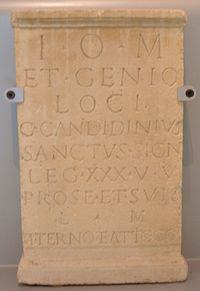
Back أماكن عبقرية Arabic Genius loci Czech Genius Loci German Genius loci Spanish Genius loci Estonian روح مکان Persian Genius loci French Genius loci Frisian Genius loci Italian ゲニウス・ロキ Japanese

In classical Roman religion, a genius loci (pl.: genii locorum) was the protective spirit of a place. It was often depicted in religious iconography as a figure holding attributes such as a cornucopia, patera (libation bowl), or snake. Many Roman altars found throughout the Western Roman Empire were dedicated to a particular genius loci. The Roman imperial cults of the Emperor and the imperial house developed in part in connection with the sacrifices made by neighborhood associations (vici) to the local genius. These 265 local districts[1] had their cult organised around the Lares Compitales (guardian spirits or lares of the crossroads), which the emperor Augustus transformed into Lares Augusti along with the Genius Augusti.[2] The emperor's genius is then regarded as the genius loci of the Roman Empire as a whole.
Roman examples of these genii can be found, for instance, at the church of St. Giles, Tockenham, Wiltshire, England, where the genius loci is depicted as a relief in the wall of a Norman church built of Roman material. This shows "a youthful and curly-haired Roman Genius worked in high relief, holding a cornucopia in his left hand and a patera in his right", which previously has been "erroneously identified as Asclepius".[3]
- ^ Number is for the city of Rome, cf. Plin. Nat. Hist. III, 66
- ^ Woolf, Greg. (2008). "Divinity and Power in Ancient Rome" in Religion and Power: Divine Kingship in the Ancient World and Beyond. Nicole Brisch (ed.)(Oriental Institute Seminars No. 4), Chicago: The Oriental Institute of the University of Chicago.
- ^ Toynbee, J. M. C. (1978). "Two Romano-British Genii", in Britannia, Vol. 9, p. 330. London: Society for the Promotion of Roman Studies.
© MMXXIII Rich X Search. We shall prevail. All rights reserved. Rich X Search